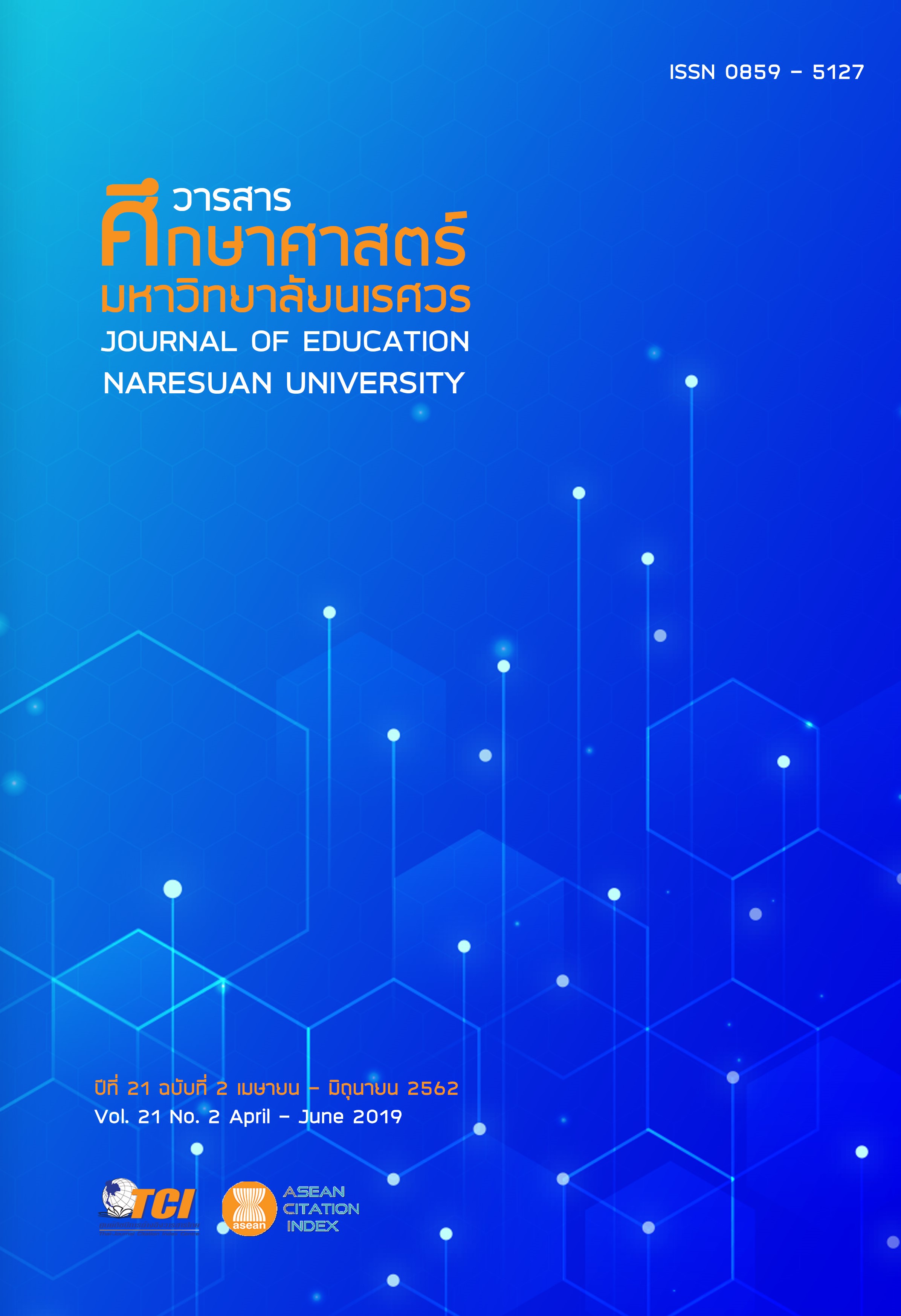การพัฒนารูปแบบการเรียนการสอนตามแนวคิดการอ่านจากต้นแบบและกลวิธีผังสัมพันธ์ของความหมายเพื่อส่งเสริมความสามารถในการอ่านเชิงวิเคราะห์ (DEVELOPMENT OF AN INSTRUCTIONAL MODEL BASED ON READING APPRENTICESHIP APPROACH AND SEMANTIC MAPPING STRATEGY FOR ENHANCING ANALYTICAL READING )
Main Article Content
Abstract
การวิจัยนี้มีวัตถุประสงค์เพื่อพัฒนารูปแบบการเรียนการสอนและเพื่อประเมินประสิทธิผลของรูปแบบการเรียนการสอนตามแนวคิดการอ่านจากต้นแบบและกลวิธีผังสัมพันธ์ของความหมาย โดยนำไปทดลองใช้กับนักศึกษาชั้นปีที่ 2 คณะครุศาสตร์ที่ลงทะเบียนเรียนรายวิชาการอ่านวิเคราะห์วิจารณ์ ในภาคการศึกษาปลาย ปีการศึกษา 2559 จำนวน 30 คน ซึ่งเป็นกลุ่มตัวอย่างแบบเจาะจง 1 กลุ่ม ระยะเวลาทดลอง 1 ภาคการศึกษา เครื่องมือที่ใช้ในการวิจัย ได้แก่ แบบทดสอบความสามารถในการอ่านเชิงวิเคราะห์ วิเคราะห์ข้อมูลโดยเปรียบเทียบคะแนนความสามารถในการอ่านเชิงวิเคราะห์ ก่อนและหลังการทดลอง โดยใช้สถิติทดสอบค่าที (t-test dependent) ผลการวิจัย พบว่า 1) รูปแบบการเรียนการสอนที่พัฒนาขึ้นมี 3 ขั้นตอน ได้แก่ 1.1) ขั้นเรียนรู้และฝึกอ่านตามต้นแบบ คือ ขั้นตอนที่ต้นแบบให้ความรู้พื้นฐานประเภทของบทอ่านและสาธิตการใช้กลวิธีการอ่าน 1.2) ขั้นอ่านและเชื่อมโยงความหมายคือ ผู้เรียนระบุความรู้เดิมที่สัมพันธ์กับบทอ่านและนำคำสำคัญจากบทอ่านมาเชื่อมโยงความสัมพันธ์ของความหมาย 1.3) ขั้นตรวจสอบและแลกเปลี่ยนประสบการณ์การอ่าน คือ ผู้เรียนแลกเปลี่ยนความรู้และวิพากษ์วิจารณ์สิ่งที่อ่าน 2) ประสิทธิผลของรูปแบบการเรียนการสอน ผลจากการทดลองใช้ พบว่า กลุ่มตัวอย่างมีคะแนนเฉลี่ยความสามารถในการอ่านเชิงวิเคราะห์สูงกว่าก่อนการทดลองอย่างมีนัยสำคัญทางสถิติที่ระดับ .01
DEVELOPMENT OF AN INSTRUCTIONAL MODEL BASED ON READING APPRENTICESHIP APPROACH AND SEMANTIC MAPPING STRATEGY FOR ENHANCING ANALYTICAL READING
The purposes of this study were to develop an instructional model based on reading apprenticeship approach and semantic mapping strategy for enhancing analytical reading ability of undergraduate students; and evaluate the efficiency of the instructional model. The research procedure was divided into phases;
1) development of an instructional model based on real problem, and 2)effectiveness evaluation of an instructional model through implementation with the subjects who were thirty undergraduate students, Suan Sunandha Rajabhat University, Thailand. The duration of experiment was one semester. The research instrument was analytical reading test. The data were analyzed by using t-test dependent. The research results showed that: 1) the objectives of the developed instructional model were to enhance analytical reading. This model consisted of 3 sub stages which were 1.1) studying and reading apprenticeship, 1.2) process of reading apprenticeship, and 1.3) experiences interchange. Quantitative and qualitative data measurement and evaluation were carried out during and after the instructional process. 2) The effectiveness of the instructional model after implementation, it was found that; the score of analytical reading higher than before the experiment at .01 level of significance in all components.
Article Details
The owner of the article does not copy or violate any of its copyright. If any copyright infringement occurs or prosecution, in any case, the Editorial Board is not involved in all the rights to the owner of the article to be performed.
References
Brenner, D. (2009). Supporting struggling readers in English education. Retrieved March 10, 2014, from https://www.researchgate.net/
2. Coleman, L. C. (1995). the effects of semantic mapping on reading comprehension levels of third-grade students in the Mississippi Delta (Doctoral dissertation). Cleveland, MS.: Delta State University.
3. Department of Academic Affairs. (2003). Learning in Thai Language based on basic education curriculum. Bangkok: Kurusapa Printing Ladphrao. [in Thai]
4. Halterman, T. J. (2013). Effects of rap paraphrasing and semantic-mapping strategies on the reading comprehension of english learners and fullyenglish-proficient students with mild-tomoderate learning disabilities (Doctoral dissertation). San Francisco, CA.: The University of San Francisco.
5. Long, M. (2012). The effects of explicit analytical reading skills instruction on the ability to solve mathematical problem in a written format in a third-grade classroom. USA.: University of Arkansas.
6. Matz, D. S. (2012). Reading apprenticeship classrooms: Effectiveness of teacher think-alouds to increase the metacognition of 7™ grade social studies students (Doctoral dissertation). Chester, PA.: Widener University.
7. Mehdian, N. (2009). Teacher’s role in the reading apprenticeship framework: Aid by the side or sage by the stage. English Language Teaching, 2(1), 3-12.
8. Ministry of Education. (2009). Create Thai children to smart reading. Bangkok: Kurusapa Printing Ladphrao. [in Thai]
9. OECD. (2013). PISA 2012 assessment and analytical framework: mathematics, reading, science, problem solving and financial literacy. Retrieved December 10, 2013, from https://dx.doi.org/10.1787/9789264190511
10. Office of the Higher Education Commission. (2013). Higher education plan 11 (2013-2016). Bangkok: Chulalongkorn University. [in Thai]
11. Phetcharat, J., & Thongbai, A. (2013). Thai language for communication. Bangkok: Odien Store. [in Thai]
12. Potter, W. J. (2005). Becoming a strategic thinker: Developing skills for success. New Jersey: Pearson Education.
13. Pressley, M., El-Dinary, P. B., Gaskins, I., Schuder, T., Bergman, J. L., Almasi, J., & Brown, R. (1992). Beyond direct explanation: Transactional instruction of reading comprehension strategies. Elementary School Journal, 92(5), 513-555.
14. Reutzel, D. R., & Cooter, R. B. (2003). Strategies for reading assessment and instruction: Helping every child succeed. NJ: Merrill Prentice Hall.
15. Sinlarat, P. (2012). Thailand qualificati ons framework. Bangkok: Chulalongkorn University. [in Thai]
16. Sukvijit, P. B., & Chinwonno, A. (2016). The effects of project-based reading instruction on English reading ability and intercultural communicative competence of undergraduate students. Journal of Education Naresuan University, 18(3), 27-44.
17. The Sirindhorn Thai Language Institute. (2010). Research report “Result of Thai Language Ability Test of student at Chulalongkorn University”. Bangkok: Chulalongkorn University. [in Thai]
18. Roskos, K., & Walker, B.J. (1994). Interactive handbook for understanding reading diagnosis. USA.: Macmillan.
19. Sinatra, R., Stahl-Gemake, J., & Morgan, N. W. (1986). Using semantic mapping after reading to organize and write original discourse. Journal of Reading, 30(1), 4-13.
20. The University of Melbourne. (2010). Help sheet reading skills. Teaching and Learning Unit, Australia: University of Melbourne.
21. Vadasy, P. F., & Nelson, J. R. (2012). Vocabulary instruction for struggling students. New York: Guilford Press.
22. Vygotsky, L. S. (1981). The instrumental method in psychology. The Concept of Activity in Soviet Psychology, 135-143.

